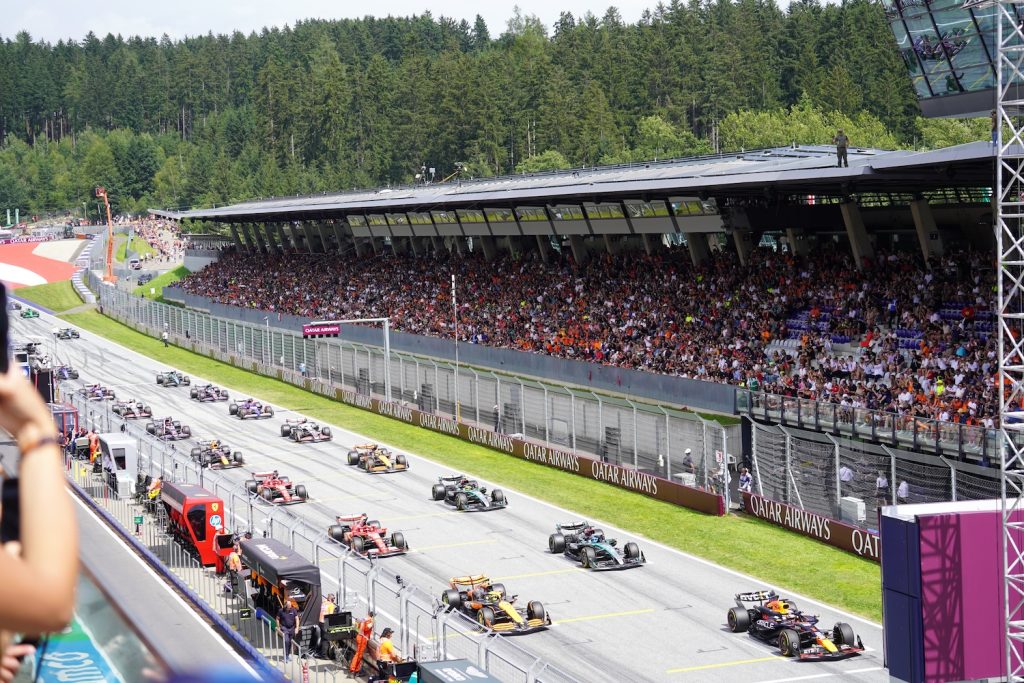
The Austrian Grand Prix returned to the Formula 1 calendar in 2014 after an eleven-year hiatus. It’s hosted at the picturesque Red Bull Ring, the most recent incarnation of the Österreichring circuit, which debuted back in 1970.
- The 2025 Austrian Grand Prix is scheduled for June 27-29.
- The Red Bull Ring will remain on the F1 calendar until at least 2030
- Tickets for the 2025 Austrian Grand Prix are on sale now via our supplier
- This post contains affiliate links. We may receive a commission if you make a purchase after clicking on one of these links
The original Österreichring circuit, measuring just under 6km, was comprised of a series of high-speed corners and elevation changes with little in the way of run off areas. American driver Mark Donohue lost his life following an accident in 1975, prompting the addition of a chicane to slow speeds on the fastest section of the circuit. Nevertheless, the Österreichring remained frighteningly fast; in 1987, Nelson Piquet’s pole lap averaged a blistering 159.457 mph (255.756 km/h). In the same year, the deficiencies of the circuit – notably the narrow start-finish straight – were highlighted by two huge crashes on the opening lap, which saw the race restarted twice.
This was the final nail in the coffin for the original circuit, which was deemed unsafe for the era’s hugely powerful turbo cars. The Österreichring lost its place on the F1 calendar in 1988 and wouldn’t return for another ten years, despite updates to the circuit in the interim years, including the widening of the pit straight and the redesign of the fearsome Bosch Curve.
A1-Ring
When it did return in 1997, the circuit had a new layout and a new name, the A1-Ring, thanks to its funding from a telecommunications company. Hermann Tilke, the track designer known for designing many of today’s F1 tracks, went to town on the original layout. It was in fact Tilke’s first major commission. Few of the fast, sweeping corners were retained for the shortened 4.3km circuit. The A1-Ring hosted seven Austrian GPs between 1997-2003, with two wins apiece for Mika Hakkinen and Michael Schumacher.

Red Bull Ring
The A1 Ring was not a money maker however, and was removed from the calendar for 2004 because of Austria’s support for anti-tobacco legislation in the EU. Enter Dietrich Mateschitz, the founder of Red Bull, who purchased the circuit and announced big redevelopment plans. No sooner had work got underway however, including demolishing the existing pit buildings, when local authorities upheld environmental complaints and halted work on the track.
It remained idle for six years until Mateschitz finally completed a less ambitious revival of the circuit. The newly named Red Bull Ring opened in 2011. It wasn’t too long before Mateschitz persuaded Bernie Ecclestone to sign a new seven-year Formula 1 hosting contract. The first race was staged in 2014 and attracted a sell-out crowd.

The Austrian Grand Prix has remained a popular round of the World Championship since re-joining the calendar, attracting as many as 200,000 spectators over the 2019 race weekend. In stark contrast, as a result of the coronavirus pandemic, the 2020 Austrian Grand Prix was the first F1 race to be held behind closed doors.
The Red Bull Ring hosted the highly-anticipated first round of a much delayed season, and made history by hosting a second successive race on the following weekend. While Valtteri Bottas won the season-opening Austrian Grand Prix, Lewis Hamilton clinched the first victory of his seventh title-winning year at the one-off Styrian Grand Prix.

The Red Bull Ring once again hosted two consecutive races in 2021. Max Verstappen won both races, becoming the first driver to win consecutive races in the same country since Damon Hill at the 1996 Australian Grand Prix. While there was a limited number of fans in the grandstands at the Styrian Grand Prix, 132,000 fans were in attendance at the Austrian Grand Prix; at the time, the largest figure since the pandemic began. The event returned with a capacity crowd in 2022. In both 2023 and 2024, weekend attendance figures grew to over 300,000.
In March 2023, it was announced that the race promoter, Projekt Spielberg, had signed a four-year contract extension with Formula 1, meaning that the Austrian Grand Prix will remain on the F1 calendar until at least 2027. Over the 2023 Austrian Grand Prix weekend, the deal was extended by a further three years. The Austrian Grand Prix will continue to be staged until at least 2030.
Austrian Grand Prix: Did You Know?
- Niki Lauda is the only Austrian driver to have won his home race. He did this in 1984, the year he took his third and final World Championship. Lauda also took 3 pole positions at the Österreichring.
- In 2021, Max Verstappen set a new record for most F1 wins in Austria. He claimed his fourth victory in the country at the 2021 Austrian Grand Prix. Alain Prost held the former record for most Austrian wins, having taken his third Austrian Grand Prix victory in 1986.
- The short track length at the Red Bull Ring often leads to tight qualifying sessions. 7 of the last 12 pole positions at the track have been decided by less than a tenth of a second.
- David Coulthard finished as runner-up at the Austrian Grand Prix for four consecutive seasons between 1997 and 2000. He finally won the event in 2001.
READ MORE: Austria’s Home Race Heroes
- Rolf Stommelen took the only podium finish of his F1 career at the Austrian Grand Prix in 1970. He finished third having started 17th – the furthest back grid position a podium finish has come from at the track.
- The 1976 Austrian Grand Prix was the last F1 race which a female driver completed. The race marked Lella Lombardi’s 12th and final race appearance, in which she finished 12th.
- Despite not winning in Austrian since 1982, Ford continued to hold the record as the most successful engine manufacture at the track for almost 40 years, with 9 victories in total between 1972 and 1982. Mercedes finally broke their record in 2024.
- From his ten Austrian Grand Prix appearances, Riccardo Patrese finished the race only twice. He has more non-finishes here than any other driver.
- Despite being the quickest lap to complete on the current calendar, with the record 2020 pole time just under 63 seconds, the Red Bull Ring is actually only the fourth shortest track on the schedule, after Monaco, Mexico and Brazil.
Memorable Moments in the Austrian Grand Prix

1987 Austrian Grand Prix: Johansson hits a deer
Stefan Johansson suffered one of the strangest F1 accidents ever in 1987 during practice for the Austrian Grand Prix, when he struck a deer on a blind crest at 180 mph (290 km/h). Very lucky to have only suffered a few broken ribs, Johannsen bravely competed in the race and finished in 7th place.
1975 Austrian Grand Prix: Brambilla crashes after winning:
Vittorio Brambilla took his only victory in the 1975 Austrian Grand Prix. The race, which was run in treacherously wet conditions, was stopped on just lap 29. Brambilla punched the air with both fists as he took the chequered flag, prompting him to lose control of his March and hit the wall!
2002 Austrian Grand Prix: Finish line controversy:
The 2002 race is remembered for all the wrong reasons. Under team orders, Rubens Barrichello yielded the lead of the race to his Ferrari team-mate Michael Schumacher on the last corner, incensing the local fans. Schumacher made a bad situation worse by trying to give Barrichello the top step on the podium after the race. This incident contributed to the FIA introducing new rules designed to prevent team orders artificially affecting the results of races.
2016 Austrian Grand Prix: Rosberg and Hamilton collide
There was more last lap controversy in 2016. Nico Rosberg was leading as the final lap began, with team-mate Lewis Hamilton right on his tail. On the run between turns 1 and 2, Hamilton visibly gained on the leading Mercedes and made a move around the outside into the second corner. Rosberg’s attempts to run his team-mate wide resulted in contact, and damaged his own front wing. Hamilton was into the lead ahead of Rosberg’s wounded car, the Brit eventually won and Rosberg finished fourth as a result of the most dramatic last lap of the season. Watch the highlights.
Austrian Grand Prix Facts
| Circuit Name | Red Bull Ring |
| Race first held | 1970 |
| Track Length | 4.318km (8 turns) |
| Race Distance | 71 laps (306.452km) |
| Lap Record (post-1996 layout) | 1:05.619, Carlos Sainz (McLaren, 2020) |
| 2024 Result | 1st George Russell (Mercedes) 1:24:22.798 |
| 2nd Oscar Piastri (McLaren) +1.906s | |
| 3rd Carlos Sainz (Ferrari) +4.533s |



